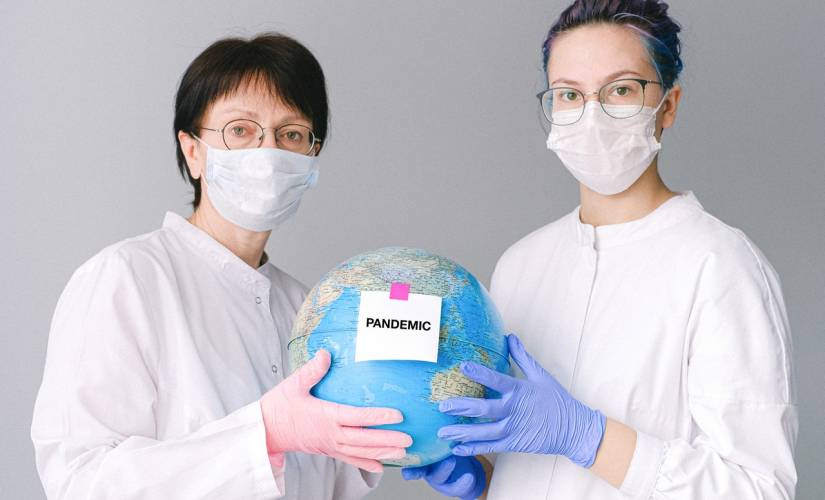It seems so simplistic to talk about the way we used to deliver healthcare, in a pre-COVID-19 world. We moved around in close proximity to our patients and delivered care mainly up close and in person. But, technology-centric healthcare is here to stay thanks to COVID-19.
Technology-Centric Healthcare
There have been people ushering in new technologies like telemedicine for decades, but the reality is we didn’t see mass adoption or implementation until a global pandemic hit.
The way we do nearly everything has been altered in some way, and we are seeing the quick adoption of digital health technologies across the healthcare continuum in an effort to stop the spread of the virus.
Once we get to a place where we are no longer laser-focused on fighting the spread, our attention will turn to a new way of delivering care in a post-COVID-19 world.
The new way of delivering healthcare is going to be a lot different than what we’ve been used to — or even what we are used to.
Why is this moment in healthcare so different?
We’ve talked about shifts in healthcare before. There is no shortage of predictions about the tech trends that will change healthcare, such as augmented reality and wearable devices.
This time is different. Take telehealth as an example.
Although it has been around for decades, doctors have not been quick to use it. In fact, 2019 – way back before the coronavirus was a reality – saw only 28% of physicians using telehealth to deliver care.
Within weeks of COVID-19 striking, practices around the country shuttered their doors to patients and saw appointment cancellations hit as high as 108%.
For doctors and patients alike, virtual care became the only option. Recent projections say virtual medical care visits will top 200 million this year. The record is up sharply from the original expectation of 36 million visits for all of 2020.
Doctors Before the Pandemic
Before the pandemic, doctors who hadn’t yet adopted telehealth to deliver care didn’t see a huge need to be able to see patients remotely.
There were other obstacles, like the issue of reimbursement which made it unattractive or impossible. Seemingly overnight, though, things changed and Americans everywhere only had one choice if they needed medical care: virtual.
Even as we flatten the curve, life will not be going back to what we used to consider normal anytime soon.
Social distancing will be something we will all have to get used to. Limiting the number of people in enclosed areas, like waiting rooms, will become the new normal.
Bigger time breaks between patients will be necessary to properly clean and sanitize exam rooms. For at least the next couple of years, we will see changes to the way we did things in healthcare, which will solidify some of the shifts ushered in to deal with COVID-19.
All the new changes will go far beyond telehealth.
Telehealth gets a lot of attention these days, but there are many different technologies that change the way doctors and patients interact that will become the new normal.
For many providers, COVID-19 has been the catalyst for adopting many of them, as digital became the only way to connect with patients.
Messaging and Monitoring
One thing providers realized quickly as the pandemic spread across the country was a need to communicate to patients easily and effectively.
While some health systems and small practices were using messaging technology prior to 2020, the reality for others sank in as they needed to cancel large numbers of appointments.
Adding to the issue is how to provide accurate information to high-risk patients, and ensure all patients had access to the latest information about the virus and its presence in their communities.
Recent Healthcare Data
Interestingly, recent data shows that those areas hardest hit by the virus that saw a dramatic uptick in doctor-patient communications. California saw a quicker flattening of the curve than those who were hard hit by the virus, who saw a smaller number of messages sent — like New York.
No matter what “normal” looks like going forward, providers will continue to leverage digital tools that allow them to communicate to, and engage with, patients with the push of a button.
Digital screening
Just like flying following 9/11, visits to the doctor are not going to look the same.
We should all get used to being screened for symptoms of COVID-19 in many areas of our lives, with doctors’ offices leading the way. Providers around the country are quickly adopting digital tools that allow them to pre-screen patients who are making and coming in for appointments.
For many people, the new screening will come in the form of a text message as part of an appointment reminder.
While many offices will leverage a mix of channels, such as voice, email and text, it is important to note that patients overwhelmingly prefer text messages. When the patient receives a text message, the reminder will include a link to a quick screener survey with a few questions to answer prior to their in-person office visit.
If any of the questions suggest they might be positive for the virus, the patient’s provider would follow up with next steps. The quick text enables the healthcare team to deliver care quickly while reducing the risk of exposure to themselves and other patients.
Zero-contact check-in
As we all have become acutely aware over the past several months, limiting the spread of the virus requires us to stay a certain distance away from others. We can all think of a number of places we visit fairly regularly where this would be difficult to avoid, and the waiting room at your doctor’s office is no exception.
As we move to re-opening offices around the country, we will see many providers implement zero-contact check-in procedures The patients can check-in virtually – including submitting co-pays. The patient then waits in their cars until they receive a text message that the doctor is ready to see them.
These new procedures not only limits doctor exposure to patients but keeps office staff from close physical interactions that might put them at risk.
Particularly innovative use of this kind of technology is one of our health system customers — which is setting up virtual triage for the emergency room to keep patients who don’t need emergency care away from an area that could put them at higher risk for COVID-19 or other diseases.
Curbside care
Much like with waiting rooms and telehealth, doctors’ offices will find ways to keep patients from having to come in when it could be risky – for them or others – to do so.
Some visits require more time and attention, others can be done relatively quickly and easily, even with a patient remaining in the car. For example, vaccinations, testing, or routine blood pressure tests can be done anywhere and don’t require the patient to go into the waiting and exam rooms.
Remember the Digital Tools
More and more providers are leveraging digital tools that enable them to check-in patients. Screening and reviewing patient information and history from electronic health records (EHR) can quickly and safely be done from the patient’s car. Proceeding in this manner with initial-contact-administrative-care protects both the patient, staff, and doctors.
Technology’s Rapid Transformation in Healthcare
Technology is constantly shifting how we deliver healthcare.
There are moments in history that push us faster toward innovation and adoption, and give us a new way of doing things. COVID-19 is one of those moments.
While much of healthcare will stay the same – and many will continue to debate whether that’s a good thing or not (that’s for another article!) – many methods will be changed for good.
Healthcare providers are in the business of making people healthier and delivering care. The pandemic tried its best to keep healthcare providers from doing just that.
With the past several months forever etched in people’s memories, providers won’t be able to go back to business as usual. Rather, they will do everything they can to ensure they are able to deliver the very best care to their patients.
Technology is the best and maybe the only way to seamlessly provide essential healthcare to patients.
Image Credit: Anna Shvets; Pexels





